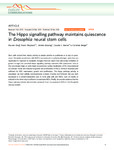The Hippo signalling pathway maintains quiescence in Drosophila neural stem cells
| dc.contributor.author | Ding, R | |
| dc.contributor.author | Weynans, K | |
| dc.contributor.author | Bossing, Torsten | |
| dc.contributor.author | Barros, Claudia | |
| dc.contributor.author | Berger, C | |
| dc.date.accessioned | 2016-04-23T17:20:13Z | |
| dc.date.available | 2016-04-23T17:20:13Z | |
| dc.date.issued | 2016-04 | |
| dc.identifier.issn | 2041-1723 | |
| dc.identifier.issn | 2041-1723 | |
| dc.identifier.other | 10510 | |
| dc.identifier.uri | http://hdl.handle.net/10026.1/4540 | |
| dc.description.abstract |
<jats:title>Abstract</jats:title><jats:p>Stem cells control their mitotic activity to decide whether to proliferate or to stay in quiescence. <jats:italic>Drosophila</jats:italic> neural stem cells (NSCs) are quiescent at early larval stages, when they are reactivated in response to metabolic changes. Here we report that cell-contact inhibition of growth through the canonical Hippo signalling pathway maintains NSC quiescence. Loss of the core kinases <jats:italic>hippo</jats:italic> or <jats:italic>warts</jats:italic> leads to premature nuclear localization of the transcriptional co-activator Yorkie and initiation of growth and proliferation in NSCs. Yorkie is necessary and sufficient for NSC reactivation, growth and proliferation. The Hippo pathway activity is modulated via inter-cellular transmembrane proteins Crumbs and Echinoid that are both expressed in a nutrient-dependent way in niche glial cells and NSCs. Loss of <jats:italic>crumbs</jats:italic> or <jats:italic>echinoid</jats:italic> in the niche only is sufficient to reactivate NSCs. Finally, we provide evidence that the Hippo pathway activity discriminates quiescent from non-quiescent NSCs in the <jats:italic>Drosophila</jats:italic> nervous system.</jats:p> | |
| dc.format.extent | 0-0 | |
| dc.format.medium | Electronic | |
| dc.language | en | |
| dc.language.iso | en | |
| dc.publisher | Springer Science and Business Media LLC | |
| dc.subject | Animals | |
| dc.subject | Drosophila | |
| dc.subject | Drosophila Proteins | |
| dc.subject | Gene Expression Regulation | |
| dc.subject | Intracellular Signaling Peptides and Proteins | |
| dc.subject | Neural Stem Cells | |
| dc.subject | Protein Serine-Threonine Kinases | |
| dc.subject | Protein Transport | |
| dc.subject | Signal Transduction | |
| dc.title | The Hippo signalling pathway maintains quiescence in Drosophila neural stem cells | |
| dc.type | journal-article | |
| dc.type | Journal Article | |
| dc.type | Research Support, Non-U.S. Gov't | |
| plymouth.author-url | https://www.webofscience.com/api/gateway?GWVersion=2&SrcApp=PARTNER_APP&SrcAuth=LinksAMR&KeyUT=WOS:000369019400002&DestLinkType=FullRecord&DestApp=ALL_WOS&UsrCustomerID=11bb513d99f797142bcfeffcc58ea008 | |
| plymouth.issue | 0 | |
| plymouth.volume | 7 | |
| plymouth.publication-status | Published online | |
| plymouth.journal | Nature Communications | |
| dc.identifier.doi | 10.1038/ncomms10510 | |
| plymouth.organisational-group | /Plymouth | |
| plymouth.organisational-group | /Plymouth/Faculty of Health | |
| plymouth.organisational-group | /Plymouth/Faculty of Health/Peninsula Medical School | |
| plymouth.organisational-group | /Plymouth/REF 2021 Researchers by UoA | |
| plymouth.organisational-group | /Plymouth/REF 2021 Researchers by UoA/UoA01 Clinical Medicine | |
| plymouth.organisational-group | /Plymouth/REF 2021 Researchers by UoA/UoA03 Allied Health Professions, Dentistry, Nursing and Pharmacy | |
| plymouth.organisational-group | /Plymouth/Research Groups | |
| plymouth.organisational-group | /Plymouth/Research Groups/Institute of Translational and Stratified Medicine (ITSMED) | |
| plymouth.organisational-group | /Plymouth/Research Groups/Institute of Translational and Stratified Medicine (ITSMED)/CBR | |
| plymouth.organisational-group | /Plymouth/Users by role | |
| plymouth.organisational-group | /Plymouth/Users by role/Academics | |
| plymouth.organisational-group | /Plymouth/Users by role/Researchers in ResearchFish submission | |
| dc.publisher.place | England | |
| dcterms.dateAccepted | 2015-12-22 | |
| dc.identifier.eissn | 2041-1723 | |
| dc.rights.embargoperiod | Not known | |
| rioxxterms.versionofrecord | 10.1038/ncomms10510 | |
| rioxxterms.licenseref.uri | http://www.rioxx.net/licenses/all-rights-reserved | |
| rioxxterms.licenseref.startdate | 2016-04 | |
| rioxxterms.type | Journal Article/Review |


